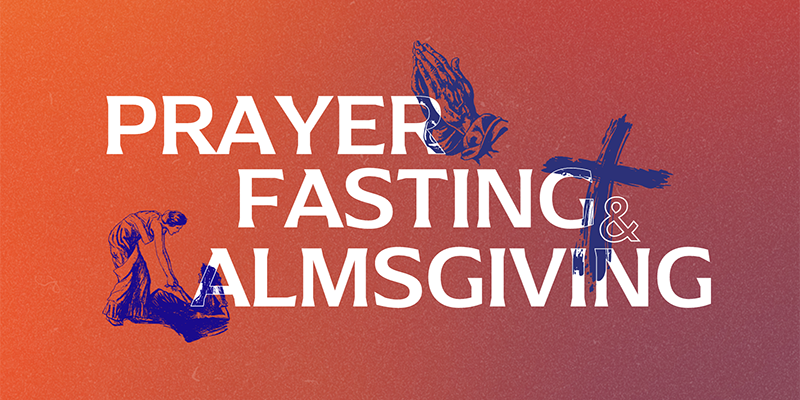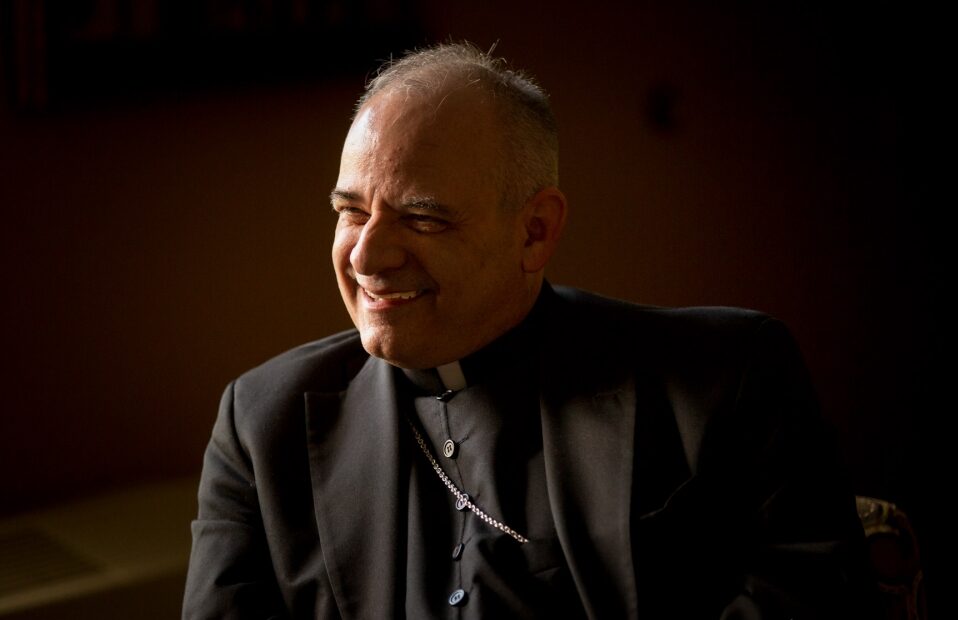Lent: A time of prayer, fasting and almsgiving to grow in relationship with the Lord

This Lent, ask yourself this question: Why?
The Lenten season is a time of prayer, fasting and almsgiving, a pathway toward Easter and Christ’s victory over death. This year, Ash Wednesday falls on Feb. 14. Easter Sunday is March 31.
Many Catholics make sacrifices or do something extra to grow in faith during this time of year. Lent is also a time in which parishes will offer special activities — a mission or revivial, Stations of the Cross, extra times for the sacrament of reconciliation, service opportunities and fish fries — to aid in the Lenten journey.
It’s important to keep in mind the “why” — rather than the “what” — when choosing to pray, fast and give alms during Lent. How are we growing in our relationship with the Lord? How are we actively using this time to share the Good News of Christ with others?
In “Disciples Make Disciples,” a new pastoral vision for the Archdiocese of St. Louis (visit theway.archstl.org), Archbishop Mitchell T. Rozanski encouraged Catholics to commit to growing deeper in faith in order to share the Good News with others. “As Catholics we believe in the salvation that is offered to us in Christ through the teachings and sacraments of the Church,” he wrote. “This is the beauty and the joy of the Easter message; that Jesus is indeed risen and offers to us the hope of eternal life forever with God.”
“I am imploring us to beg God to rekindle a real, true, personal and authentic relationship with each one of us and to set our hearts on fire for love of Him and for each other,” the archbishop continued. “An authentic encounter with Jesus always leads us to encounter others in a new way.”
Beginning next week, the Review will offer a three-part series exploring the aspects of prayer, fasting and almsgiving, especially how these elements, united with a time of eucharistic revival, can help us to grow in closer relationship with the Christ.

Prayer
Make a list of 40 people to pray for. Dedicate 40 minutes a day to pray for one person each day. Or choose one person for whom to pray for 40 minutes a day for all 40 days.
Explore the resources found within “The Way: A Journey Toward Renewal and Vitality” a new experience in the Archdiocese of St. Louis to guide parishes and ministries in formulating a clear vision rooted in evangelization and assist them in exploring diverse approaches to creating a path for discipleship. The archbishop’s pastoral vision, “Disciples Make Disciples,” and resources with “The Way” can be found theway.archstl.org.
Practice Lectio Divina in daily prayer; or try Visio Divina and visit the Saint John’s Bible, which is on permanent display at Cathedral Basilica of Saint Louis. Visit www.seeingtheword.org.
Pray in front of Planned Parenthood.
Commit to a Lenten spiritual practice that extends once Lent is over, such as attending a weekday Mass, signing up for a time at adoration or silent time in the afternoon for spiritual reading.
Use time in the car to listen to spiritual podcasts or music, or dedicate that time each day to silence.
Make a morning offering.
Pray the Rosary daily.
Do a nightly examen.
Spiritually adopt priests, seminarians or religious — write to them and let them know you are praying for their vocations.
Catholic Lent Madness (www.catholiclentmadness.wordpress.com) is an online game created by the Citrowske family to engage with families during Lent. Participants will learn about the saints and vote for their favorites, in the style of basketball March Madness.

Fasting
Give up your favorite place to shop.
Make simple meals.
Give up snacking between meals.
Go to bed earlier.
Work on habits to help be a better person — review them in a morning offering and nightly examen.
Spend less time on digital devices.
Give up social media. Look for an app that tracks screen time. Or completely eliminate all screen time — phones, TVs and tablets.
Give up the snooze button.
Declutter.
Go without makeup.
Limit or eliminate non-essential purchases.
Give up alcohol.
Make a grapevine wreath filled with toothpicks to represent Jesus’ crown of thorns. As each person makes some kind of sacrifice for Jesus or a neighbor, a thorn is removed from the wreath so it is no longer hurting Jesus. The goal is to teach reparation of sins.

Almsgiving
Make a good-deeds jar: For every good deed or sacrifice, add a bead, colorful plastic hearts, jelly beans or other cool item. Do enough good deeds to fill the jar by Easter.
Choose a person to receive random acts of kindness anonymously.
Abstain from a favorite treat and donate the saved money to the Rice Bowl. (www.crsricebowl.org)
Help your children choose a toy to donate and discuss sharing blessings with others.
Bring formula, diapers or other baby supplies to a local pregnancy resource center.
Visit the elderly.
Volunteer at your parish or a local charity.
Handwrite letters to people who have influenced you in some way.
Do your Lenten practice with a friend to hold one another accountable. Mix it up and assign one another a Lenten practice.
Each day during Lent, call someone with whom you haven’t connected in a while. Use the time to intentionally listen and connect with that person.
Invite others for Friday activities during Lent, such as Stations of the Cross or meatless meals.
Archdiocesan Lenten regulations
“For God so loved the world that he gave his only Son, so that everyone who believes in him might not perish but might have eternal life. For God did not send his Son into the world to condemn the world, but that the world might be saved through him” (John 3:16-17).
The Church has always helped us fulfill these words of Jesus by prescribing very definite penance for all Catholics, so that we too might have eternal life. Accordingly, the pope and the American bishops have outlined obligatory fast and abstinence guidelines as follows:
Ash Wednesday (Feb. 14), all Fridays of Lent and Good Friday (March 29) are days of abstinence (refraining from meat) for all Catholics from age 14 onwards. On Ash Wednesday and Good Friday, fast, as well as abstinence, is also obligatory for those from the ages of 18-59. Abstinence means refraining from meat. Fast means one full meal a day, with two smaller meals and nothing between meals (liquids are permitted). No Catholic will lightly excuse himself or herself from this obligation.
A note about Ash Wednesday and Valentine’s Day
This year, Valentine’s Day coincides with Ash Wednesday. But don’t expect a dispensation from the obligation to fast and abstain from meat. Catholics throughout the world recognize Ash Wednesday as the solemn beginning of a period of prayerful reflection and penance, as is evident by the large number of churchgoers on this day, said Father Nicholas Smith, director of the archdiocesan Office of Worship. In view of the significance of Ash Wednesday, the obligation of fasting and abstinence must naturally be the priority in the Catholic community. A recommendation would be celebrating Valentine’s Day one day early, which also happens to be Mardi Gras, a traditionally festive time before the beginning of the Lenten observance.
Additional Lenten resources
• Augustine Institute Formed: formed.org
• Best Lent Ever daily reflections: dynamiccatholic.com/best-lent-ever
• Word on Fire Lenten Reflections: www.wordonfire.org/reflections/
This Lent, ask yourself this question: Why? The Lenten season is a time of prayer, fasting and almsgiving, a pathway toward Easter and Christ’s victory over death. This year, Ash … Lent: A time of prayer, fasting and almsgiving to grow in relationship with the Lord
Subscribe to Read All St. Louis Review Stories
All readers receive 5 stories to read free per month. After that, readers will need to be logged in.
If you are currently receive the St. Louis Review at your home or office, please send your name and address (and subscriber id if you know it) to subscriptions@stlouisreview.com to get your login information.
If you are not currently a subscriber to the St. Louis Review, please contact subscriptions@stlouisreview.com for information on how to subscribe.







